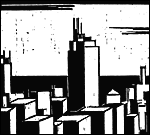Tom Wolfe, The Kandy-Kolored Tangerine-Flake Streamlined Baby (Farrar, Straus & Giroux, 1965) Tom Wolfe is a prominent enough and talented enough writer to now be "deconstructed" by critics. Despite the current trend for panning Wolfe, his status as the original proponent of New Journalism, if nothing else, will ensure his legacy. The Kandy-Kolored Tangerine-Flake Streamlined Baby started the phenomenon of New Journalism; at the very least, it was a departure from Wolfe's traditional newspaper writing style and the beginning of a literary journalistic career. Originally the title of an article he wrote for Esquire, The Kandy-Kolored Tangerine-Flake Streamlined Baby is also the title of his first book published in 1965 by Farrar, Straus & Giroux. The book was a collection of his best 22 articles written for New York Magazine (then the Sunday supplement for the New York Herald-Tribune) and Esquire. The original article came about when Wolfe went to California to report on the strange subculture of teenagers who customized their cars. He began to see these individuals as artists who merited study. He hung out in California to complete his character studies and examination of this new trend, racking up a $750 bill at the Beverly Wilshire (all paid for by Esquire). When he eventually returned to New York, he found that his writing style that he had cultivated as a newspaper reporter could not adequately describe the weird, psychedelic atmosphere that he'd experienced in California. Eventually, he called his editor to tell him he couldn't complete the piece. The editor told him to write up his notes so that another writer could finish the job. At 8 o'clock one evening, Wolfe began his notes. In an attempt to provide every possible detail for another writer who had not seen the customized cars, Wolfe wrote in a stream-of-consciousness style, almost in the vein of James Joyce, including even his most garbled notes. He finished at 5 o'clock the next morning. Esquire ran it as it was. This style remained his trademark, and the odd punctuation and personalized syntax was often (poorly) imitated throughout the '60s. Jack Kroll said that Wolfe was "a genuine poet" able "to get under the skin of a phenomenon and transmit its metabolic rhythm." Wolfe writes in a modern version of the verisimilitude of the nineteenth century Realists: he appropriates the language of the Californian teenagers to evoke the scene. He entertains, but his perceptions are such that he has coined many popular phrases such as "radical chic" and "the Me Decade." The other articles in the book The Kandy-Kolored Tangerine-Flake Streamlined Baby include articles where Wolfe's investigative eye focuses on Las Vegas, The Peppermint Lounge, demolition derbies, Muhammed Ali, bouffant hairdos, doormen, and nannies. What the disparate topics have in common is their analysis by Wolfe as a trend in popular culture. The 1960s were a time of huge social change, and Wolfe examined the new ways of gaining status, while satirizing the old guard as they tried to claw desperately to their way of doing things. Kurt Vonnegut, in a review for the book in the New York Times said: "He knows everything. I do not mean he thinks he know everything. He is loaded with facile junk, as all personal journalists have to be _ otherwise, how can they write so amusingly and so fast? Verdict: excellent book by a genius who will do anything to get attention." New Journalism is perhaps hard to define. In a Writer's Digest article, Wolfe defined it thus: "the use by people writing nonfiction of techniques which heretofore had been thought of as confined to the novel or to the short story, to create in one form both the kind of objective reality of journalism and the subjective reality that people have always gone to the novel for." We can say that New Journalism contains certain elements borrowed from fiction writing, such as extended character development, extensive scene-setting and dialogue, shifting point-of-view, and varying degrees of innovation in the use of language and punctuation _ basically encapsulated in the work of Tom Wolfe. As journalists, we have many lessons to learn from Wolfe. From his writing style, we can see that journalism does not have to be mundane, it can be crafted to be a piece of writing worthy of being cherished, then "deconstructed" (and no doubt praised once again). His writing could not be what it is without his detailed, patient and meticulous reporting. He takes as long as he needs to analyze his subjects, trends, and then only after serious investigative reporting does he wrap the story up in his satirical prose to present it back to society as some sort of mirror. If nothing else, Wolfe is evidence that out of a potentially career-breaking situation (deadline looming, nothing to show for it apart from a huge hotel bill), good things can emerge: he is a journalistic pioneer, pushing the borders of convention out of desperation not to be constricted. Other Reviews: Richard Kallan, Dictionary of Literary Biography: "Whatever his future literary offerings, Wolfe this far has delivered a bursting portfolio of provocative observations and thoughts. When students of American culture look back on the last one third of the twentieth century, Tom Wolfe may well be the person toward whom they turn. More than any other fiction / nonfiction writer, he recorded in detail the popular mentality of the period. For this reason his essays seem certain to be restudied. Already signs of reevaluation and discussion of his work are evident: once criticism focused on Wolfe's writing style and his school of journalism, but now it looks more to the meaning and implications of his message." |
 |
|||||||||||||||||||||||||||